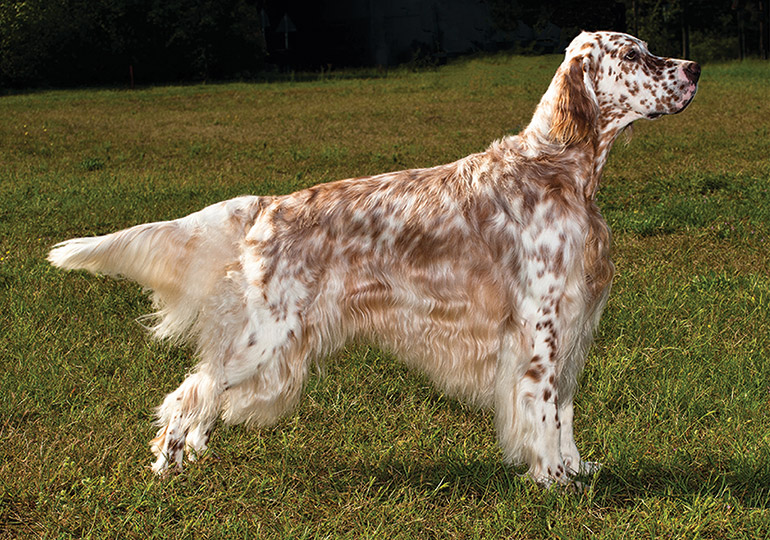Breeds
English Setter

GROUP 3 - GUNDOGS
History
English Setters are one of the oldest Gundog breeds and are traceable to the 14th century. The breed was valued for its hunting ability and unusual characteristic of dropping into a low crouch on finding birds. This was described as ‘setting’.
The breed we recognise today largely developed during the 18th and 19th centuries by careful selection for working characteristics, soundness of limb and temperament, together with a large dose of elegant good looks. Selective breeding produced the medium-sized, distinctively coated and good-natured breed we are familiar with today.
Temperament
The English Setter has a gentle nature, a friendly manner and an intelligent and alert expression. Keen to please and often referred to as the ‘gentleman’s gentleman’, it is an active, energetic breed with a keen game sense and good scenting powers. It shows great enthusiasm for work and play.
The English Setter enjoys its run in the park or daily walk, but it is equally at home curled up in a favourite chair.
Appearance
The modern English Setter owes its appearance to Mr Edward Laverack, who developed the breed during the 19th century. Another Englishman, Mr Llewellin, based his strain on Laverack’s best dogs and outcrossed them to produce the field type known as the Llewellin Setter. In 1902 the Llewellin Setter was given separate strain status in the UK, however, fieldbred English Setters are often mistakenly referred to as Llewellin. Only purebred Llewellin Setters may be registered as such.
The English Setter gives the immediate impression of being a sporting dog of aristocratic and noble heritage. It is of medium height: dogs are between 65 and 69cm at the withers and bitches are between 61 and 65cm. It projects an image of elegance both in appearance and on the move and exhibits the stamina required to allow it to work all day in the field. With its head carried high, the English Setter has a strong jawline and a long, muscular neck. It has bright, expressive, brown eyes and low ears, hanging in neat folds close to the cheek.
Health
Canine Hip and Elbow Dysplasia can be an issue in the breed, but responsible breeding practices are reducing the incidence and severity of the problem.
There is also a small incidence of hereditary deafness in the breed, but this can now be detected in puppies as young as five weeks old. A responsible breeder will be only too pleased to advise whether the puppy has been checked, plus supply you with worming and vaccination schedules, advice on proper housing, exercise and diet.
English Setters can be expected to live between 11-14 years.
Maintenance
This gentle, affectionate family dog loves to be with people and gets quite lonely when isolated in a yard or kennel.
Athletic and energetic, it requires daily exercise either on leash or in a fenced area. A bored dog turns to other diversions, so you will need to be prepared to regularly put aside an hour or two for exercise and play.
Its beautiful, silky coat is easy to look after. A good brush several times a week, checking for tangles, and a little trimming around the neck, ears and feet is all that is required.
Suitability
The English Setter is an affectionate and loyal breed that is thoroughly trustworthy with people and other animals. When coupled with its medium size, this makes the breed an ideal family dog. This is a breed that will adapt easily to your lifestyle whether you are seeking a companion, a show dog, a dog for agility or obedience or a working dog.
The English Setter is known to bark a lot if not stimulated properly, mentally and physically, so it is ideal for those with time to walk and play with it.
Words: Richard Jones on behalf of the English Setter Club of NSW.
Image: Shutterstock.com
In Conclusion
Now you know a little about the English Setter, you may think that this is the dog for you. Before you make a decision, please make contact with the breed club or your State controlling body for purebred dogs. They will be able to give you information about available puppies and also suggest dog shows where you can see the breed and speak to breeders. In this way you will gain a better perspective of the English Setter and its needs, and whether this breed would suit your lifestyle.
Breeders



